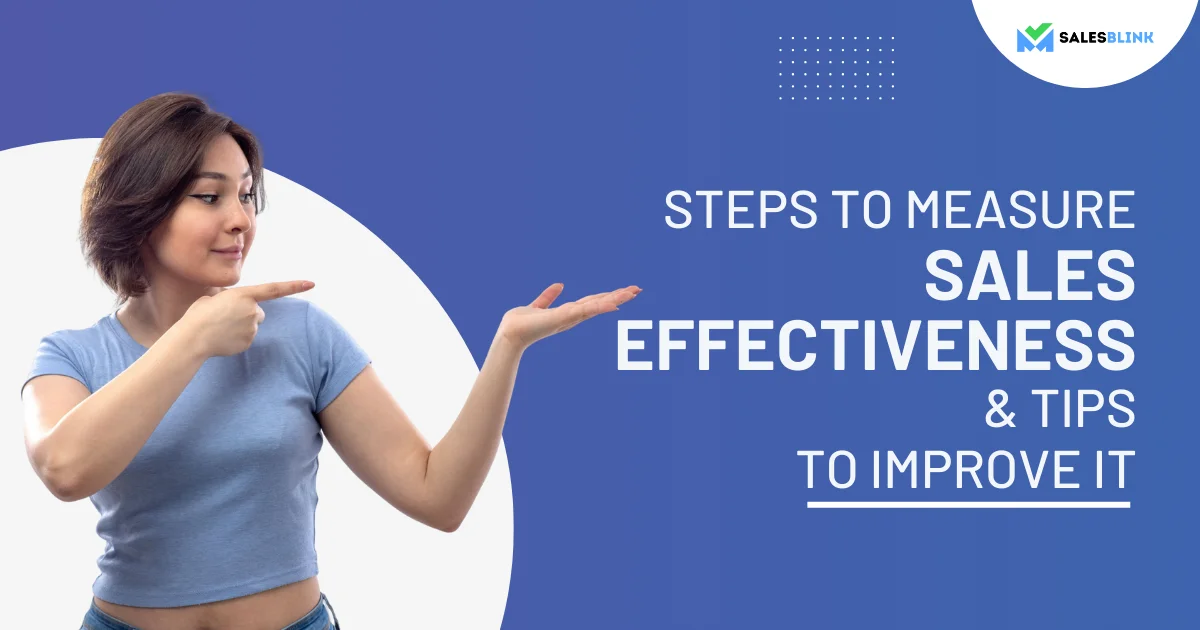Steps To Measure Sales Effectiveness & Tips To Improve It
Ever wondered whether your sales team is achieving the 5:1 sales ROI golden ratio? If you don’t pay attention to it, you won’t know if the team is accomplishing its goals and whether your efforts are bearing fruit or not. If you are new to heading a sales team, you may not know about measuring sales effectiveness but that’s okay as help is at hand.
In this blog post, we’ll show you how to measure sales effectiveness with tips to increase it so that your team is always increasing the profits of the organization.
So without further ado, let’s begin!
Table of Contents
What Is Sales Effectiveness?
The sales effectiveness of a sales team measures how it accomplishes its objectives.
Being effective means achieving goals, while being efficient in sales saves resources to make money.
It involves completing transactions, keeping clients, and building long-lasting bonds. A successful sales force not only sells but also builds relationships with customers. They understand their problems and offer personalized solutions.
Organizations can build a solid foundation for growth by focusing on being efficient. This means ensuring that every sales activity adds to revenue and customer satisfaction.
What Is Sales Efficiency?
Sales efficiency means making the most of time, money, and resources used during sales.
It all comes down to limiting input and optimizing output. Efficient sales teams increase productivity by streamlining processes, utilizing technology, and removing obstacles.
It is possible to save money and time by becoming more efficient and handling more transactions. The sales team must balance efficiency and effectiveness to boost revenue and meet customers.
Sales Effectiveness Metrics You Should Be Tracking

Here are some Sales Effectiveness metrics you should keep track of:
1. Fluctuations In Sales Team Activities
Variations in the actions of the sales team function as a measure of their adaptability.
Companies gain vital information by watching how their team responds to market changes. To create agile strategies, analyze market trends and customer behaviors to ensure they match.
The outcome is a vibrant and adaptable team prepared to handle the market’s shifting expectations.
2. Sales Lead Response Time
Sales lead response time is a metric that measures the duration it takes for a sales team or representative to respond to a new lead or inquiry. It’s the time when a lead shows interest, and the sales team makes first contact. This metric is critical because faster response times often lead to higher conversion rates. The speed and success of a sales team in connecting with customers affect their sales.
3. Length Of Sales Cycle
Understanding your sales cycle’s length is essential to the success of your organization. A shorter cycle is a sign of excellent client engagement and operational efficiency. Streamlining processes saves money and increases sales productivity.
This simple method boosts profits and ensures a competitive edge, making it a vital sales measure.
4. New Customer Acquisition Rates
The New customer acquisition rate measures how a business gets new customers in a set time. To find the percentage, divide the new customers by the total potential or existing customers.
Assessing marketing strategies, sales efforts, and business growth depends on this important metric. A high acquisition rate means a successful strategy for getting and keeping new customers. To attract more customers, marketing, sales, or product positioning need to make changes due to a low rate.
5. Effectiveness Per Territory, Product, Etc.
Analyzing how well something works based on things like products or areas can change sales.
It provides accurate information that allows for customized sales and marketing plans. Organizations can boost sales and engage customers by tailoring strategies to different markets.
This targeted approach promotes profitability and steady growth by ensuring effective resource allocation.
6. Customer Turnover Rate
Customer Turnover Rate, often referred to as Customer Churn Rate, is a metric used in evaluating sales effectiveness, particularly in businesses that rely on repeat customers or subscriptions. It measures the rate at which customers stop doing business with a company over a specific period. This metric is crucial for understanding customer retention and satisfaction, and it can significantly impact a company’s revenue and long-term success.
7. Individual Effectiveness Against The Average
Individual Effectiveness Against The Average is a metric used to compare the performance of individual sales representatives against the average performance within a team or organization. This comparison helps in identifying how well each salesperson is performing in relation to their peers. It’s an important tool for sales managers and teams to gauge individual contributions, strengths, weaknesses, and areas for improvement
8. Impact Of Investments On Effectiveness
It is crucial to check investments. This metric refers to analyzing how different types of investments — such as training, technology, marketing, and product development — affect the performance and efficiency of a sales team or organization. This concept is key in strategic decision-making, as it helps in understanding where to allocate resources to maximize returns in terms of sales growth and efficiency.
9. Net Profitability
Net Profitability in the context of sales effectiveness is an essential financial metric that gauges the actual profit a company generates from its sales activities after accounting for all costs and expenses. It’s an essential indicator of a company’s financial health and the efficiency and effectiveness of its sales operations.
How to Measure Sales Effectiveness?
There are a few steps to measure the effectiveness of sales, and those are as follows:
1. Study Your Sales Pipeline

A thorough analysis of the sales funnel is essential to optimize the sales process and gain insight into client behavior.
Businesses can discover barriers and efficiently improve their plans by pinpointing the stages at which prospects drop off.
These insights facilitate the execution of focused solutions, such as improving product demos, resolving typical objections, or customizing communications.
Through consistent observation and modification of tactics grounded on analysis, organizations can guarantee improved prospect flow, elevated conversion rates, and, eventually, higher revenue.
2. Analyze Your Engagement Rates
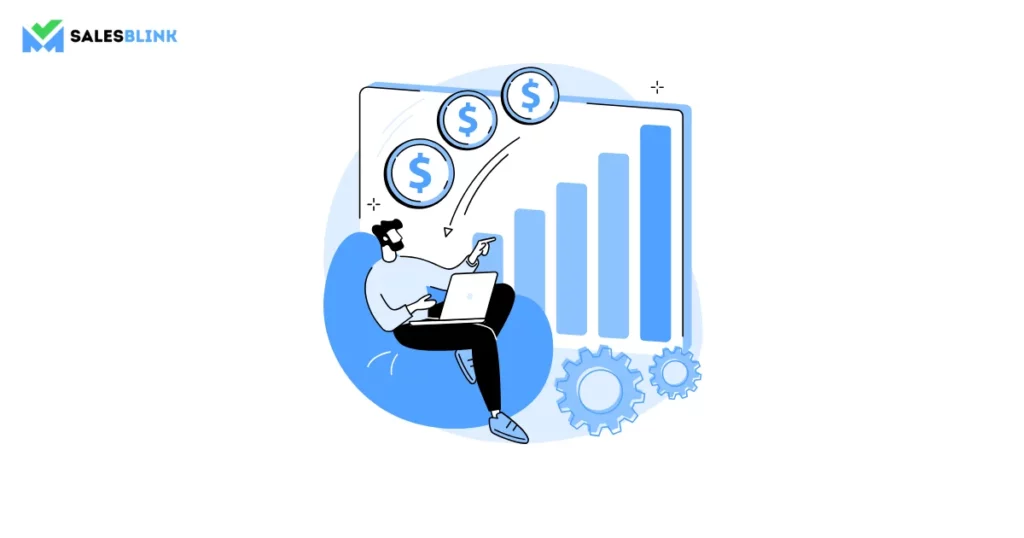
Analyzing your engagement rates is a key aspect of measuring sales effectiveness. Engagement rates reflect how well your sales team connects with potential and existing customers, and these interactions are critical for building relationships, understanding customer needs, and ultimately driving sales. Focus on email open &v response rates, meeting conversion rates & social media engagement with the help of analytics tools.
3. Keep Track of Wins and Losses

Analyzing the small parts of successful and unsuccessful deals helps improve the sales strategy.
You can discover customer preferences, objections, and pain points by analyzing common patterns.
Successful transactions have certain things in common. To meet client needs, you must understand their desires, find effective solutions, and foster rapport.
Losing business can show you what you need to work on, like knowing your products better or addressing specific concerns.
Your sales team can use this study to understand clients better. They can make adjustments, customize pitches, and address concerns based on them.
To improve their chances of success, businesses should learn from both their wins and losses. They can then build stronger customer connections.
4. Check on the Customer After the Sale

To encourage customers to come back and recommend you, we need to keep them happy after the sale.
Surveys, feedback forms, and routine follow-ups are excellent ways to check customers’ satisfaction.
When businesses ask for feedback, they show they care about customers and learn how to improve.
Responding to consumer complaints fixes problems and builds consumer confidence.
Customers who are happy with a brand are more likely to become brand ambassadors. This generates goodwill and attracts new customers.
To succeed in a competitive world, businesses need to focus on customer satisfaction. By doing so, they can keep their current clients and set the stage for long-term success and growth.
Tips to Boost Sales Effectiveness
Following are some tips to boost the effectiveness of sales:
1. Continuously Optimize the Process
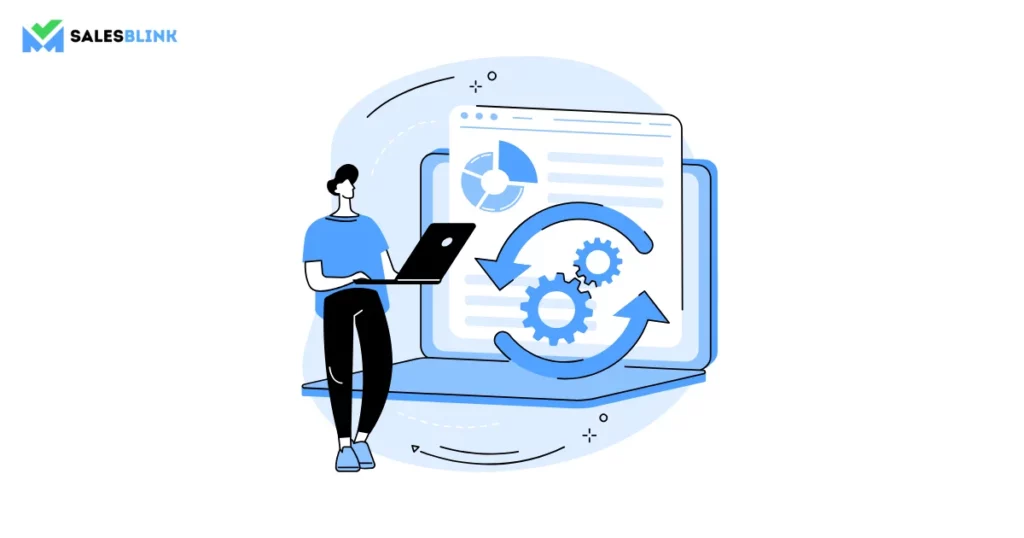
Be flexible in your sales procedures to adapt to changing client preferences and market conditions. Regular assessments help you stay on track with trends and client expectations. They act as a compass for your strategies. Keep an eye out for new technology, competition, and market changes. They can help you adjust your strategy. Adapting is about something other than keeping up. It’s also about making room for new ideas. It’s about creating customized experiences for clients that engage people. By adjusting your processes, you can stay ahead of competitors and keep loyal customers.
2. Invest in Training
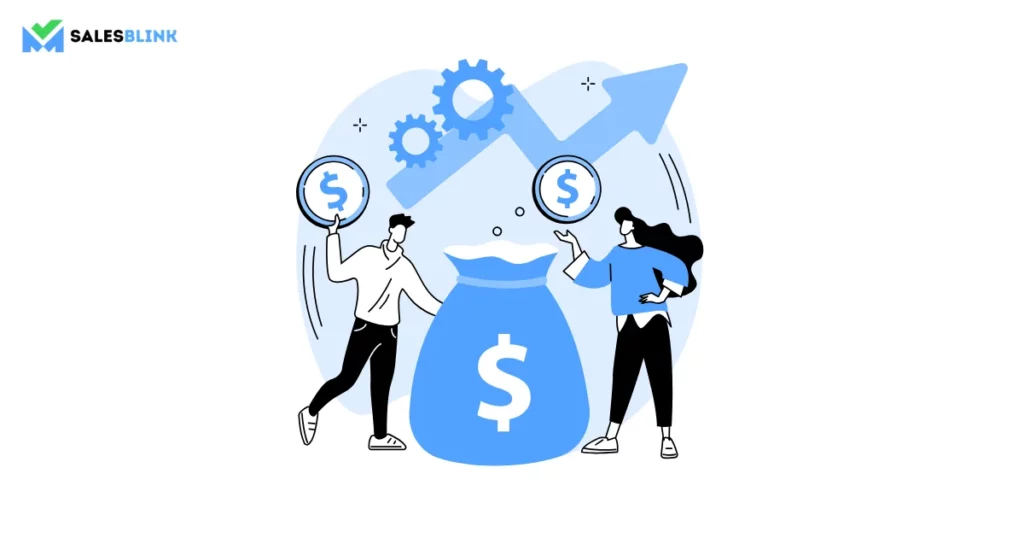
Empower your sales team through ongoing training initiatives. This investment isn’t in knowledge; it’s in the foundation of credibility and confidence. Train your sales reps well. Teach them the latest strategies, methodologies, and your products. Their expertise helps them handle different consumer needs and build trust during sales. To help your team promote your products, make sure they know about industry trends, technology, and competition. By being proactive, you can improve sales outcomes and increase revenue in a competitive market.
3. Track Your Sales Team’s Workload
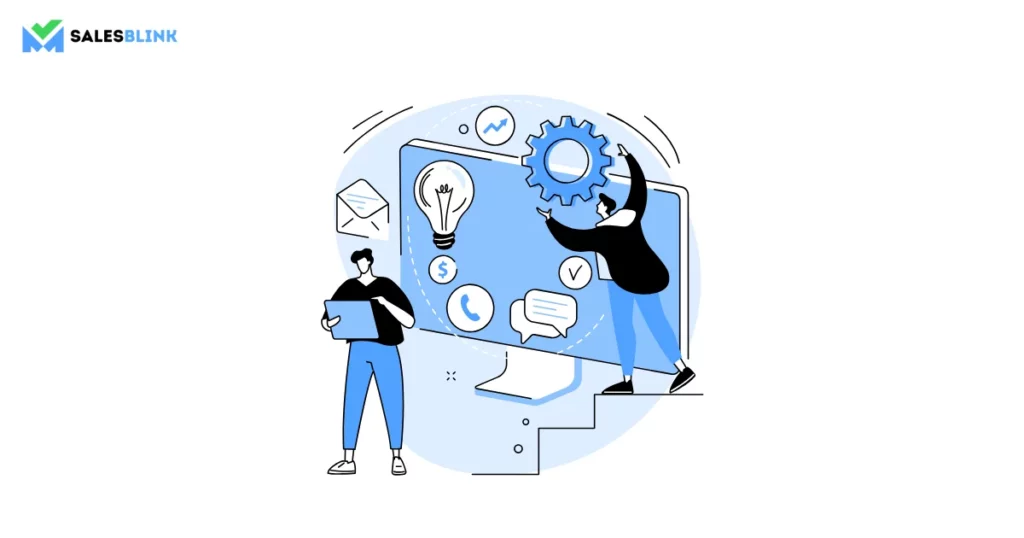
Keeping a balanced workload for your sales team is vital for productivity and well-being. Use workload-tracking technologies to distribute responsibilities among team members. If they can focus on building relationships with customers, they won’t feel overwhelmed by repetitive tasks. Strong relationships are crucial in sales. They increase customer satisfaction, establish trust, and form the basis for long-term connections. A balanced workload helps productivity and creates a positive workplace. It boosts morale and team efficiency. Use technology to track work and adjust tasks to motivate and prevent burnout in your sales team. This helps them stay engaged and resilient.
4. Time Your Interactions with Clients

Strategic timing in client interactions can be a game-changer. Use data analysis to pinpoint the optimal moments to engage with prospects. Find the times when customers are most receptive by looking at response time data. Plan discussions to show respect for their time and encourage meaningful conversations. This approach isn’t about making contact; it’s about building rapport and trust. You can use it to spark interest, send messages, and form lasting connections with clients. Timing is important when using data to make decisions and interact with clients. This can lead to successful outcomes.
5. Act on the Sales Insights You Gain
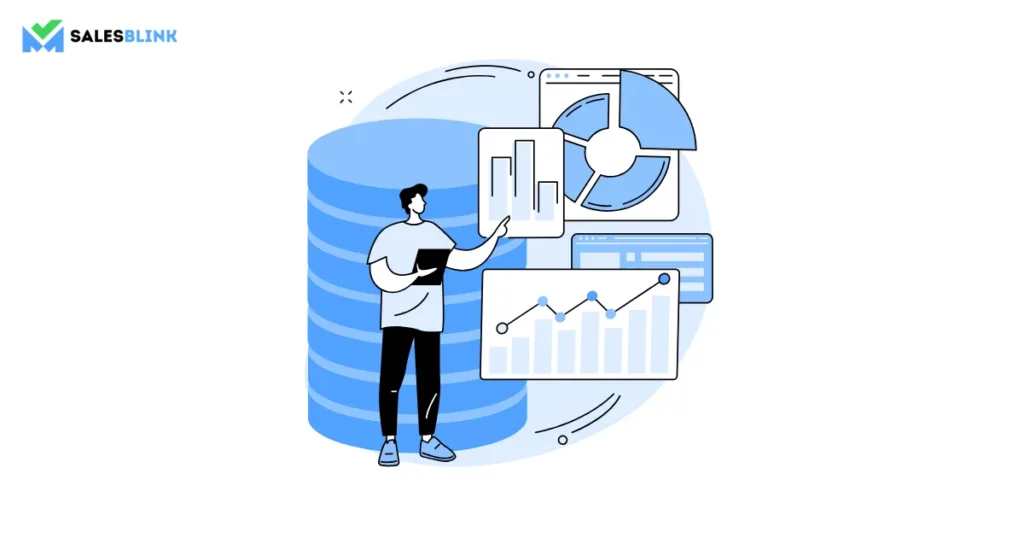
Make the most of the power of data-driven insights to navigate today’s competitive marketplace. Analyze sales data to discover important buying patterns and industry shifts. You can apply this knowledge to create better plans and improve products. Also use it to customize ads and provide clients with unique experiences. Allocating resources based on these insights amplifies the impact of your sales initiatives.
Additionally, adapting to these data-driven sales strategies keeps your organization ahead. This is important as customer preferences and market trends change over time. To improve your sales process, analyze data. This helps you make smarter choices and boost productivity. This will improve your chances of meeting sales targets.
Sales Effectiveness Tools
Several solutions enable sales teams to improve their efficacy in the digital age. Let’s take a look at them.
1. SalesBlink
SalesBlink is a unique platform for automating the sales process. It transforms outreach, and follow-up processes.
SalesBlink takes cold outreach automation to new levels with several exciting features. These features include tracking emails and seamless CRM integrations with any CRM. By tracking email responses and opens, you can understand the sequence is performing & know how effective it is.
Overall, SalesBlink makes the sales outreach process easier.
2. HubSpot Sales Hub
HubSpot Sales Hub is an innovative solution for sales teams. It offers various tools such as prospect management, email monitoring, and sales automation.
Robust features and an easy-to-use interface work together to ease complicated sales procedures. To improve prospect handling and build connections, teams should centralize lead management.
The platform’s email tracking feature gives you immediate insights to help with measuring sales effectiveness. It ensures timely and personalized follow-ups.
Your team can focus on important tasks because the automation features streamline repetitive work.
3. LinkedIn Sales Navigator
LinkedIn Sales Navigator is an invaluable resource. It offers knowledge and networking opportunities for sales professionals.
Sales teams can identify important decision-makers in target firms by using advanced features. This feature improves outreach efforts with customized communication that attracts potential customers. Also, you can customize plans using the platform’s helpful analytics and data.
It is possible to create significant connections based on informed involvement, increasing credibility and trust.
LinkedIn Sales Navigator helps businesses increase sales and revenue by expanding their networks.
4. Zendesk Sell
Zendesk Sell is a helpful sales tool. It keeps all important customer data in one place. It also helps with communication and tracking deals.
By combining data, it gives a full picture of how clients interact to make prospects happier.
Zendesk Sell provides useful reports and analytics. They show sales progress, conversion rates, and customer behaviors.
You can use these observations to improve, sell better, and make data-driven choices.
Use Zendesk Sell to adjust your strategies & stay competitive. This can lead to an increase in sales and satisfied customers.
5. ZoomInfo
In B2B transactions, ZoomInfo is a priceless tool for sales teams. The database has a lot of contacts that provide accurate information on companies and individuals.
Salespeople can use ZoomInfo to find potential customers, which gives them an advantage. They can also learn more about their target audience. Teams can use this data to tailor their pitches and improve their prospecting.
The platform’s deep insights streamline lead creation and make tailored communication more accessible. This helps sales teams build genuine relationships.
ZoomInfo is a necessary tool for business-to-business sales. It helps companies improve their outreach tactics and build lasting customer relationships.
Go Ahead And Measure Sales Effectiveness
Gaining efficacy is the key to long-term success in the fast-paced sales world. To understand customer behavior and adapt, businesses should focus on specific indicators.
Combining data-driven decision-making and state-of-the-art tools in this digital age increases sales effectiveness. It opens the door to increased productivity, profitability, and long-lasting customer relationships.
Effective salesmanship is more than just a tactic; it’s the foundation for long-term company success.
Happy measuring!
FAQs
You can use different measures to measure the effectiveness of a sales campaign. When considering a business, it’s important to think about the number of customers, acquisition costs, sales growth, customer retention, and customer satisfaction.
To improve sales, concentrate on strategy, procedures, customer targeting, training, technology, analytics, and team motivation. The effective integration of these elements ensures a comprehensive and effective sales strategy.
Sales enablement is very important for sales teams because it gives them the things they need to talk to potential customers. Salespeople who have good knowledge can connect with clients, meet their needs, and close deals faster.
